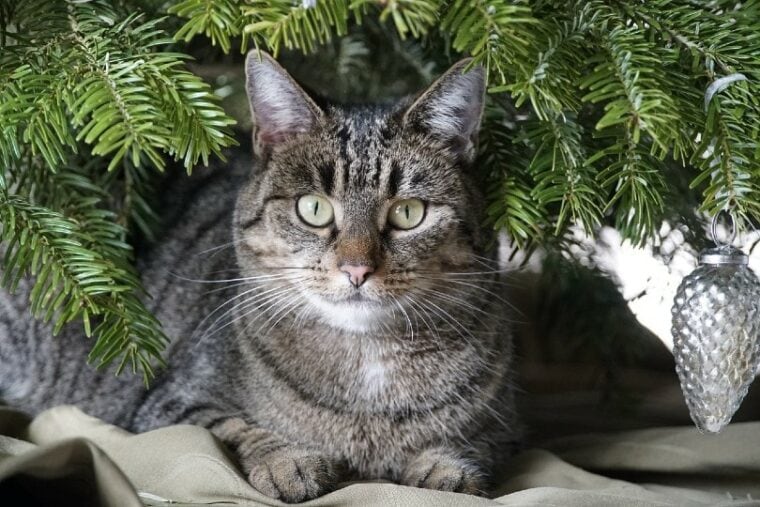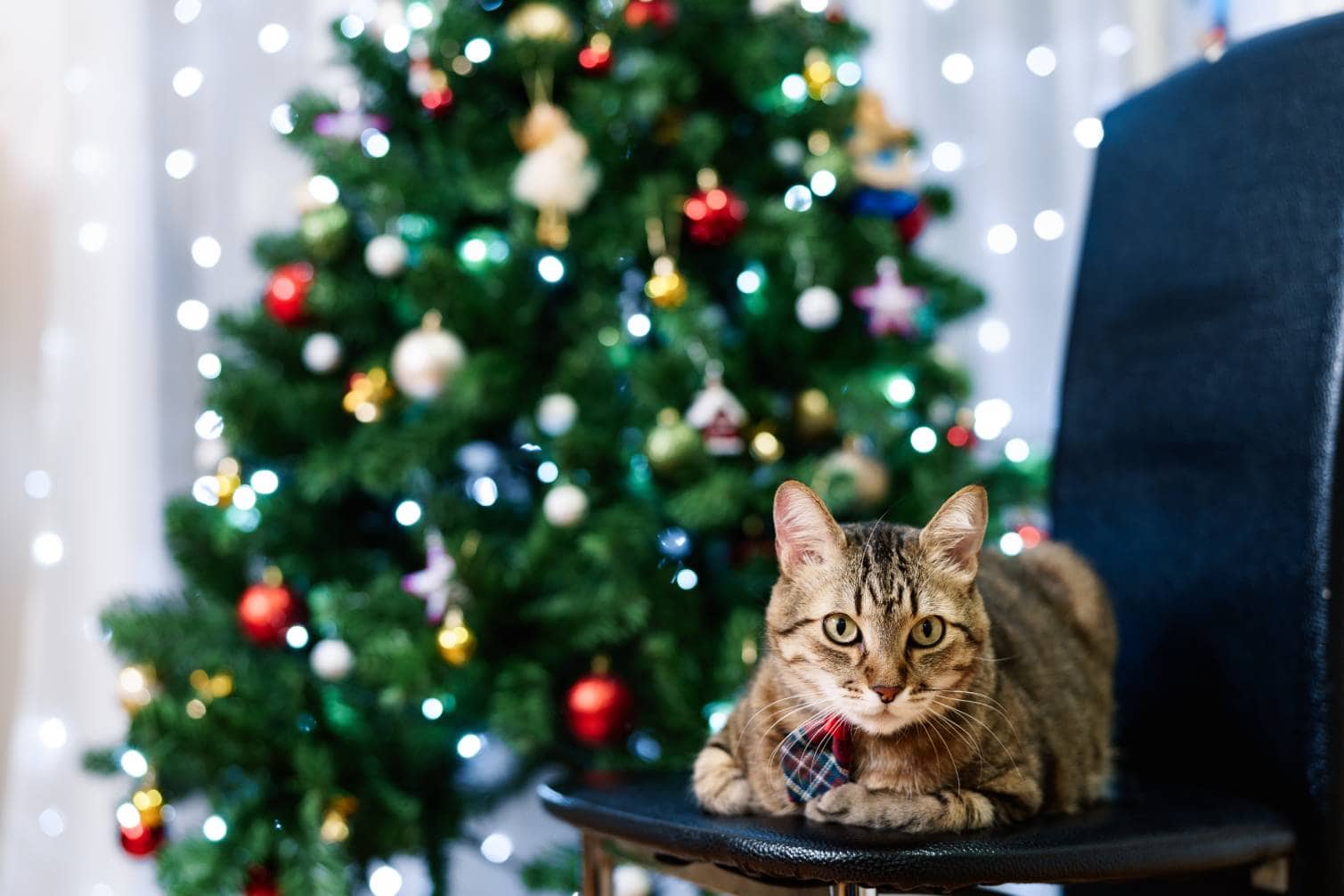
Christmas is an exciting time of year for cats; it’s a season full of new scents to explore and stuff to get into. There are trees to climb, ornaments to destroy, and tons of boxes to jump in and out of. Also, your pet can rely on distracted guests to leave their holiday food on paper plates on the coffee table. While feline antics can be adorable, no one wants to spend an evening at the animal hospital because their pet got into something dangerous. Read on for 11 Christmas safety tips for cats.
The 11 Christmas Safety Tips for Cats That You Need to Know
1. Secure Your Live Tree
Cats are notorious for climbing up, jumping, and napping in Christmas trees. The best way to prevent catastrophe along the lines of a cat jumping into and pulling down a tree is to use a secure system to fix the tree to the wall or ceiling.
Alternatively, use the heaviest stand possible. Fir tree needles are mildly toxic to cats¹, so if your cat eats a ton of fallen needles, it may throw up or have diarrhea. And tree needles can hurt your pet’s mouth if they bite down on one the wrong way. Cover the base where you refresh the water to keep your cat from drinking dirty water that may contain unhealthy chemicals such as preservatives, pesticides, plant food, and flame retardants.
Fill the tree’s base frequently with fresh water, but forgo the “tree food” since it often contains chemicals that can be toxic to cats.

2. Avoid Toxic Plants
Ivy wreaths and holly arrangements add charm and cheer to the holiday season. Plants rest at the heart of many holiday traditions, from mistletoe to Christmas trees. But some greenery traditionally associated with Christmas can be harmful to cats. English Ivy, holly, Christmas roses, and mistletoe¹ are all toxic to cats and can result in a late-night visit to the veterinary hospital if your pet eats enough.
The best way to minimize the danger of your companion eating a toxic plant is to keep them out of the house. You can find festive alternatives, such as the Christmas cactus and frosty fern; they’re non-toxic to cats, so they won’t cause problems if your pet takes a few bites. Contact your pet’s veterinarian immediately if you suspect your buddy has eaten something problematic and it becomes lethargic, throws up, or has diarrhea.
3. Don’t Give Your Cat Human Food
While allowing your cat to have a bite or two of your favorite holiday goodies may seem harmless, consuming human food can be harmful to your pet. Chocolate, onions, and chives¹ are all highly toxic to cats.
All are toxic when eaten in sufficient quantities, as are raisins, grapes, and coffee. And most human food, particularly holiday treats, have entirely too much fat and salt for cats, which can lead to an upset tummy. If you’re serving turkey, duck, chicken, or fish for your celebration, consider cooking just a bit without salt or other seasonings so your cat can safely get in on the holiday fun. But avoid giving your pet raw or undercooked meat or fish, and if your cat has to have a bite of your (garlic and onion-free) broccoli cheese bake, it will likely be fine.

4. Skip the Candles
Candles and cats don’t mix. As most cat companions know, kitties enjoy knocking things over, including candles, which can result in a fire.
You can use large candles with a broad base and place them in water-filled bowls if you can’t imagine Christmas without candlelight. You’ll get the same atmosphere, but your cat won’t be able to knock the candles over and start a fire quite as easily. Keep your pet away from lit candles to prevent singed whiskers and paws. And as always, never leave lit candles unattended, even if your cat is safely napping elsewhere.
5. Use LED-Battery Operated Tree Lights
Cats tend to chew on items like electrical cords. If a cat starts gnawing on an electrical cord and manages to bite through while the lights are plugged in, it could be electrocuted, and the damaged wires could start a fire.
Battery-operated lights are almost always better than the plug-in kind since your cat won’t be electrocuted if they bite through the cord. Place all lights as deeply into the tree as possible to keep the wires out of your cat’s paws.
And only leave the lights plugged in when you’re in the room to supervise. Consider placing any tree you purchase in an area where you can shut the door when you’re not present, as cats often get up to less mischief when under supervision.

6. Skip the Fake Snow and Snow Globes
Fake snow looks pretty, but it can cause problems for your pet, as it often contains chemicals that can be toxic to cats if they eat enough. If your pet tends to nibble on things, consider skipping the fake snow, as it often causes sensitive cats to throw up or have diarrhea. Take your buddy to the veterinarian immediately if they eat a bit of something coated with fake snow and begin to salivate or experience gastrointestinal issues.
Snow globes appear to be pure fun, but they are often filled with ethylene glycol, otherwise known as antifreeze. If your cat knocks a snow globe over and ingests even a tiny amount of the liquid inside, you’re looking at a potential veterinary emergency. Ethylene glycol is highly toxic to cats¹. Contact your veterinarian immediately if you suspect your pet has ingested any ethylene glycol, as outcomes are related to how quickly treatment begins after exposure.
7. Be Selective with Ornaments
It’s almost a given that your pet will enjoy batting at ornaments dangling invitingly from the tree. While you can try hanging fragile ornaments higher in the tree to keep them out of your cat’s reach, chances are your pet will climb the tree and destroy your stuff anyway.
Avoid glass ornaments since they can lead to a paw injury if your cat breaks them. Candy canes and other edibles wrapped in plastic can also be problematic, as cats can end up with digestive blockages if they eat the plastic. Knitted and crocheted options can also be dangerous if your pet gets hold of one and ingests a long piece of yarn.
The little hooks some people use to hang ornaments can get stuck in cats’ mouths, so consider only using them high in the tree.

8. Avoid Tinsel, Ribbons, and Tape
Tinsel and ribbons are major holiday dangers. Long, thin items such as tinsel, ribbons, and yarn often cause bowel obstructions in cats. The condition can be fatal if not treated promptly. It’s generally best to avoid decorating your tree with tinsel if you have a cat. And it’s also a good idea to avoid using ribbon for those pretty finishing touches.
Cranberry and popcorn strings make wonderful sustainable decorations but can be extremely dangerous for cats, as the string can get caught on your cat’s tongue and cause a bowel obstruction if consumed.
Consider keeping a trash bag on hand when opening gifts so you can immediately throw away the tape, ribbon, and plastic packaging.
9. Use Wooden or Metal Artificial Trees
Artificial trees are often considered safer options for households with pets, as there aren’t any tree needles or preservatives to worry about. But artificial products also come with their own set of hazards, including the possibility that your cat might eat one of the needles and end up with an abdominal obstruction requiring urgent treatment.
There are alternative artisanal trees made of everything from metal to wood. You can use the trees year after year, and they’re safer for pets, as they’re more difficult, if not impossible, to consume. However, you’ll still need to use cat-friendly ornaments for safety and be extra careful not to hang ornaments with hooks in places your pet can easily reach.

10. Don’t Leave Edible Gifts and Catnip Unattended
Cats can sniff out a treat in a second, and most are happy to help themselves to whatever goodies they find—even if it means getting creative and finding a way to unwrap a gift in the dark of night. It’s often best not to put edible gifts and catnip toys under the tree until the gift-opening time comes around.
11. Immediately Put Away Potentially Harmful Gifts
If your household gift list includes products that could be toxic to your cat, like essential oils¹, yarn¹, alcohol¹, and marijuana-infused products¹, store them in a secure location that your pet cannot access. After your family or guests unwrap their presents, collect the ones that could hurt your pet and store them in a closet or drawer.
Conclusion
Cats add just the right bit of adventure to the holidays, and it’s almost impossible to completely avoid feline naughtiness during the Christmas season. With a few precautions, your cat can safely enjoy Christmas with abandon. By securing your tree, avoiding toxic Christmas plants and decorations, and keeping your kitty away from holiday treats, you can enjoy a happy and healthy holiday with your favorite feline.
- See also: 11 New Year’s Eve Safety Tips for Dogs
Featured Image Credit: beauty_of_nature, Pixabay







